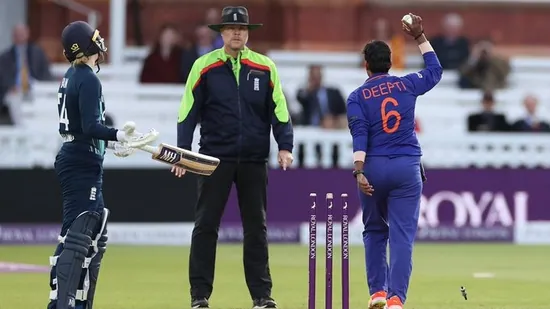Chess, cricket and telling black and white apart
A little over a month ago, when India’s prodigy GM Rameshbabu Praggnanandhaa defeated world chess champion Magnus Carlsen in a rapid match at the FTX Crypto Cup, You Tuber @abhiandniyu put out a message, “chess is the new cricket. Prove me wrong.” Carlsen responded with a four-point takedown: “Cricket is played on a field with humans, chess is played on a board with wooden pieces. Cricket has a bat and a ball, chess usually doesn’t. There are 22 players needed for a cricket match, while chess is only two. I can’t play cricket.”  PREMIUM
PREMIUM
His response was chortled and snickered over by the chess community but looking around us, it’s like cricket and chess are engaged in an intimate tussle over who owns and controls the realm of the ridiculous. Two professional sports in step with 21st century appear to have decided that the way forward can only be approached with shoe laces tied together. Honestly, you couldn’t make this stuff up if you tried.
In chess, swords are drawn over Carlsen’s tempestuous response to teenage American Hans Niemann who broke his 53-game winning streak. World No 49 Niemann, a last-minute replacement at the Sinquefield Cup, beat world No 1 Carlsen in 31 moves. Carlsen withdrew from the $500,000 event with a mysterious tweet, featuring a Jose Mourinho video saying. “If I speak I am in big trouble. Big, big trouble.” Two weeks later, in an online match against Niemann, Carlsen resigned after one move and switched off his video.
Only madness has followed—Carlsen has directly accused Niemann of cheating “more recently than he has publicly admitted”, there were suggestions of anal bead usage plus offers of naked chess. Marketing men could rub their hands at the creation of a hyper-mano-a-mano rivalry, that too featuring an American which leads everyone into a much bigger market.
But chess is plagued by online cheating and when its biggest star accuses a rival, it takes on credibility crisis levels. Chess.com, a 57-language internet chess server, news and social networking website instantly removed Niemann’s account from their matches.
Except Carlsen’s pillars of reasoning to arrive at conclusions of cheating stood on shaky ground. They involved mind-reading and body-language. Carlsen found that Niemann “wasn’t tense or fully concentrating on the game.” This is cheating uncovered through psychic intervention. He did say that he was “limited” from speaking openly without Niemann’s “explicit permission.”
If that doesn’t sound bizarre in itself, what transpired around the cricket world was virtually paranormal: ‘cheating’ outrage erupted after an event which matched one of the rule-book descriptions of ‘run out.’ We were told however that what was under attack was not cricket’s rules per se, but the game’s invisible Holy Book, titled the ‘Spirit of Cricket’ (SOC), which sort of writes itself as it goes along.
Reveal alert: SOC is actually first cousin of the Hogwarts’ Book of Admittance which is written by the Quill of Acceptance. Remember that? The magic Quill that sensed the arrival of children born with magic and wrote down their names in the Book well before they actually turned up for admission.
The SOC has slightly different magic powers. It spontaneously manifests itself around incidents where an old establishment feels it is being hard done by. The SOC is then ceremonially paid obeisance to, heated discussion, debate or dissing breaks out over some piffle and threats of extinction are fiercely invoked. The SOC can be read in whichever language its reader understands, but its first edition in English is the one that is most widely distributed. Depending on how the general vibe at the time, the SOC is often accompanied by a short appendix called Drawing The Line, but apparently this was not required to apparate in the most recent outbreak.
The body that officiates cricket internationally, ICC, has used its Twitter handle to turn the Deepti Sharma-Charlie Dean run out episode (because that is what it was) into a series of social media straw polls. The aim being to generate the heat, dust and noise of many millions likes, dislikes, retweets and responses.
On the other side, on Friday, chess bosses FIDE established an investigatory panel to check Carlsen’s claims of cheating and Niemann’s confessions to online chess cheating at age 12 and 16. Their cheating detection statistical programme, developed by University of Buffalo’s Dr Ken Regan, PhD in complexity theory, is expected to throw light.
At first, it may seem hard to pick a winner between chess’ mind-reading 101 and cricket’s SOC evocation. But cricket’s—in this case, its oldest clan aka England’s—devotion to SOC incantations has remained steadfast in the face of logic or rule amendments. That plus the refusal to recognise the difference between rules being applied and rules being bent.
On the other hand, chess’ numero uno thought leader Garry Kasparov called his sport’s entire hullaballoo “hearsay and cryptic bullshit.” He said while he understood the pressure Carlsen was under, walking out of a tournament was unacceptable and that the integrity of the game was paramount. Its online cheating issues notwithstanding, at least chess has a better grasp of what integrity—or for that matter cheating—means. Try saying those words around cricket and see what happens.
In response to the ‘chess is the new cricket’ claim, there should have been a fifth point of difference—chess can tell the difference between black and white.
Experience unrestricted digital access with HT Premium
Explore amazing offers on HT + Economist Start 14 Days Free Trial Already Subscribed? Sign In
Disclaimer: The copyright of this article belongs to the original author. Reposting this article is solely for the purpose of information dissemination and does not constitute any investment advice. If there is any infringement, please contact us immediately. We will make corrections or deletions as necessary. Thank you.







